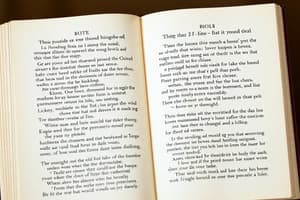Podcast
Questions and Answers
What is the definition of repetition?
What is the definition of repetition?
- the repetition of consonant sounds anywhere within words
- a figure of speech that compares two unlike things
- using the same words and phrases (correct)
- to state again or in a new form
What does restatement mean?
What does restatement mean?
to state again or in a new form
Define anaphora.
Define anaphora.
same word or phrase in the beginning of a sentence
What is epistrophe?
What is epistrophe?
What does anadiplosis refer to?
What does anadiplosis refer to?
Define parallelism.
Define parallelism.
What is alliteration?
What is alliteration?
Define rhyme.
Define rhyme.
What is tautology?
What is tautology?
Define consonance.
Define consonance.
What is assonance?
What is assonance?
Define allusion.
Define allusion.
What is apostrophe in literature?
What is apostrophe in literature?
Define simile.
Define simile.
What is a metaphor?
What is a metaphor?
Define symbolism.
Define symbolism.
What does metonymy mean?
What does metonymy mean?
Define synecdoche.
Define synecdoche.
What is personification?
What is personification?
Define anthropomorphism.
Define anthropomorphism.
What does litotes refer to?
What does litotes refer to?
Flashcards
Repetition
Repetition
The use of the same words and phrases to reinforce ideas or themes.
Restatement
Restatement
Expressing an idea again, often with slight modifications for better understanding.
Anaphora
Anaphora
Repeating the same word or phrase at the beginnings of successive sentences, creating emphasis and rhythm.
Epistrophe
Epistrophe
Signup and view all the flashcards
Anadiplosis
Anadiplosis
Signup and view all the flashcards
Parallelism
Parallelism
Signup and view all the flashcards
Alliteration
Alliteration
Signup and view all the flashcards
Rhyme
Rhyme
Signup and view all the flashcards
Tautology
Tautology
Signup and view all the flashcards
Consonance
Consonance
Signup and view all the flashcards
Assonance
Assonance
Signup and view all the flashcards
Allusion
Allusion
Signup and view all the flashcards
Apostrophe
Apostrophe
Signup and view all the flashcards
Simile
Simile
Signup and view all the flashcards
Metaphor
Metaphor
Signup and view all the flashcards
Symbolism
Symbolism
Signup and view all the flashcards
Metonymy
Metonymy
Signup and view all the flashcards
Synecdoche
Synecdoche
Signup and view all the flashcards
Personification
Personification
Signup and view all the flashcards
Anthropomorphism
Anthropomorphism
Signup and view all the flashcards
Litotes
Litotes
Signup and view all the flashcards
Study Notes
Repetition
- Repetition involves the use of the same words and phrases to reinforce ideas or themes.
Restatement
- Restatement refers to expressing an idea again, often with slight modifications to enhance understanding.
Anaphora
- Anaphora is the repetition of the same word or phrase at the beginning of successive sentences, creating emphasis and rhythm.
Epistrophe
- Epistrophe features the repetition of a word or group at the end of successive clauses, contributing to a strong rhythmic effect.
Anadiplosis
- Anadiplosis is the repetition of the last word of one clause at the beginning of the next, linking ideas closely together.
Parallelism
- Parallelism structures sentences to place equal grammatical constructions in close proximity, enhancing clarity and balance.
Alliteration
- Alliteration is the repetition of the same initial sound in a sequence of words, often used to create a musical effect.
Rhyme
- Rhyme consists of repeating accented vowel sounds and all subsequent sounds in nearby words, commonly found in poetry.
Tautology
- Tautology represents needless repetition that does not add any new meaning to the expression, often considered redundant.
Consonance
- Consonance refers to the repetition of consonant sounds, occurring anywhere within words, distinguishing it from alliteration.
Assonance
- Assonance is the repetition of vowel sounds within closely positioned words, crucial for rhythm and musicality in poetry.
Allusion
- An allusion is a brief reference to a well-known literary, mythological, or historical figure or event, enriching the text's meaning.
Apostrophe
- Apostrophe involves directly addressing an absent or imaginary person as if they were present, often used to express emotion.
Simile
- Simile is a figure of speech that compares two unlike things using "like" or "as," enhancing imagery and understanding.
Metaphor
- A metaphor makes a direct comparison between two distinct things, suggesting a shared quality or characteristic.
Symbolism
- Symbolism utilizes symbols to represent ideas or concepts beyond their literal meaning, allowing for deeper interpretation.
Metonymy
- Metonymy replaces the name of a thing with the name of something closely associated with it, such as "lend me your ears" meaning to listen.
Synecdoche
- Synecdoche involves using a part of something to represent the whole, as in "She really likes your wheels," referring to a car.
Personification
- Personification attributes human-like qualities to inanimate objects or abstract ideas, allowing for relatable imagery.
Anthropomorphism
- Anthropomorphism is a specific type of personification where animals are depicted with human characteristics and behaviors.
Litotes
- Litotes uses deliberate understatement to emphasize a point by negating its opposite, such as stating someone isn't as young as they once were.
Studying That Suits You
Use AI to generate personalized quizzes and flashcards to suit your learning preferences.




